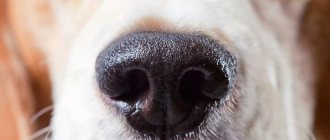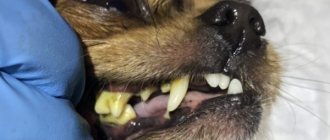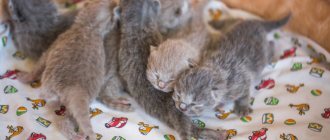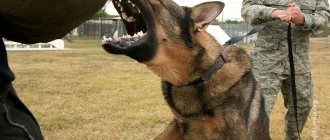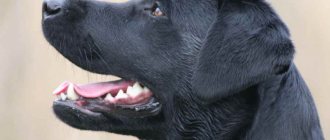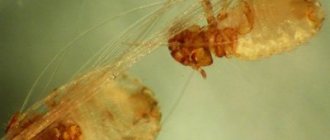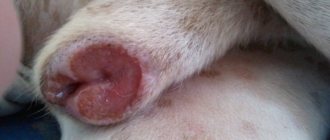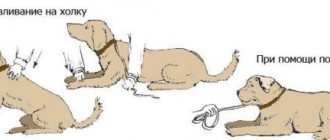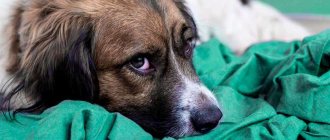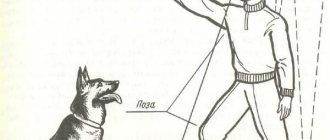Intestinal obstruction is a serious condition in dogs. In the absence or delay of help, the animal may even die. Signs of the disease can be mild and in most cases resemble simple poisoning. Some owners unknowingly ignore symptoms or self-medicate, which only worsens an already difficult situation. Therefore, it is so important to know the symptoms of intestinal obstruction in order to immediately respond and take the sick animal to the doctor.
Causes of the disease
Blockages or obstructions in dogs are divided into three main groups:
- Mechanical, the most common. Occurs for the following reasons: - incorrect dosage of food (especially relevant for starving dogs from the street); - indigestible or difficult to digest food. This includes sinews and bones, which the dog can swallow whole; - ingestion of foreign objects while walking or at home; — blockage as a result of worms after a course of deworming (manifests mainly in young dogs). Mechanical intestinal blockage is entirely the fault of the owner. Before taking an animal home, you need to study the rules of keeping and care, know about the diet and not overfeed the puppy. Deworming must be carried out strictly according to the schedule, even if you do not often walk with the puppy and he does not communicate with his relatives. For games, select appropriate toys that are sold in pet stores. Do not give your pet small sticks, foam toys, stones and small objects. If there are children in the family, then children's toys must be kept in a special play bag or closet so that the dog does not get to them.
- Pathological blockage - appears as a result of tumors in the gastrointestinal tract.
- Physiological obstruction is associated with volvulus. The main reason for this is the dog’s overactive behavior after eating a large amount of food. Also, obstruction can occur as a result of trauma to the peritoneum, compression of the intestine by other organs. Physiological obstruction is divided into: - acute - develops very quickly, accompanied by numerous symptoms. This type of blockage is very dangerous and requires immediate medical attention. The prognosis for recovery is favorable if you visit a veterinary clinic in a timely manner; - chronic obstruction, which may not manifest itself for a long time. Mainly caused by diseases of the stomach and intestines.
Preventive measures
Volvulus in dogs cannot be called a common disease. This problem is very easy to prevent if you know the first prerequisites and causes of indigestion. Veterinarians have compiled a list of rules that will help prevent the disease:
- Be sure to follow the diet (feeding two or three times a day in small portions in the proportion of 50% protein, 40% carbohydrates and 10% fat, with a complex content of calcium and other minerals and vitamins);
- Physical activity is allowed only after 1.5-2 hours, the pet cannot be lifted or caressed;
- All diseases of the esophagus and intestines must be cured completely to avoid complications;
- If natural feeding is used, you should not give foods that are difficult to digest; For dry feeding, only expensive food of super-premium class and higher is used.
Also read the article: “Causes and treatment of diarrhea in dogs.”
You need to be afraid of volvulus. This pathological process is deadly, but easily preventable. The main thing is to monitor the pet’s nutrition and activity, and if the disease manifests itself, urgently take measures to save the dog.
First signs
As already written above, many dog owners mistake obstruction for ordinary poisoning. It’s not surprising, because the symptoms of the diseases are very similar:
- weakness;
- decreased appetite;
- nausea and vomiting;
- bloating;
- pain in the abdomen.
These are the primary symptoms. If there is no bowel movement during a walk, the animal feels unwell, does not eat, and pain in the abdomen is noticeable in its behavior, then these are most likely signs of intestinal obstruction, and you should consult a veterinarian as soon as possible.
If you ignore the primary symptoms, your pet’s condition will worsen and lead to the following problems:
- the tone of the abdominal muscles will increase, the dog will try to stretch the hind limbs, while straining the tips of the paws;
- due to the large amount of gases, strong rumbling in the stomach will begin;
- frequent prolonged belching with an unpleasant odor;
- continuous vomiting. It is possible to excrete feces along with vomit.
With such symptoms, the dog can still be saved if you consult a specialist in time. In some cases, intestinal rupture and necrosis occurs, accompanied by dehydration. Obstruction can also be partial, but it is also dangerous and requires contacting a veterinary clinic.
Clinical symptoms
To some extent depend on the location of the obstruction. Obstruction of the small intestine often manifests itself as acute attacks of uncontrollable vomiting with the release of feces in front of these, often liquid (diarrhea) in nature.
When there is blood in the feces, it is dark in color and has a tarry consistency. There is a short-term release of formed or liquid feces, after which the symptoms stop. Animals with short-term obstruction are observed and have a history of intermittent vomiting and diarrhea.
With intussusception, vomiting may be observed along with the release of feces, which quickly decrease in volume and become bloody in nature, resembling red currant jelly in appearance. Tumors may partially block the intestine before causing complete obstruction. Ulcers often form, so the feces may contain altered or fresh blood.
In all cases, animals experience not only vomiting and diarrhea, but also dehydration, food refusal and depression, and abdominal pain is also possible. Palpation of foreign bodies can be difficult due to the free movement of intestinal loops in the abdominal cavity. Intussusceptions are often palpated as fairly static, hard, sausage-like structures in a more fixed position. Small tumors are difficult to palpate in the early stages.
Vomiting can be a teaspoon every half hour or a liter 2-3 times a day. In any case, with intestinal obstruction this symptom is always present and gradually increases.
How to help a dog at home?
The main rule for the owner of a dog with intestinal obstruction is not to self-medicate! There is no need to force your dog to eat or drink. Do not give your pet antiemetics or laxatives. Approved medications include painkillers and antispasmodics.
Even if you are outside the city, you should find an opportunity and deliver the sick animal to a veterinary clinic. A dog with intestinal obstruction dies two days after the first symptoms of the disease are detected.
Establishing diagnosis
Intestinal obstruction in most cases requires a careful clinical examination and detailed information about the animal's condition over the next few days. Contrary to popular belief, X-rays do not always allow one to accurately determine the presence or absence of intestinal obstruction. The fact is that soft and synthetic materials are most often transparent to X-rays, which means they are indistinguishable in the image.
There are various auxiliary technologies for X-ray diagnosis of intestinal obstruction (for example: a study with a contrast agent), but their practical value is relative. If obstruction is suspected, barium is used with caution because bowel perforation may occur, allowing barium to leak into the peritoneal cavity.
Where it cannot dissolve. In cases of suspected perforation, gastrografin (Schering Chemicals) is used, which is absorbed; this substance also provides a satisfactory contrast. Ultrasound also does not have sufficient information to detect intestinal obstruction.
Treatment and diagnosis
To detect the disease, the dog must undergo a diagnostic examination, which includes:
- ultrasound examination of the abdominal cavity;
- X-ray;
- general urine and blood tests to detect intoxication;
- examination by a veterinarian, palpation of the abdomen to detect tone and pain.
If a dog has eaten a foreign body that cannot be seen with an x-ray, the pet is given a special contrast agent to accurately identify the object. After some time, the images are repeated, and depending on the movement of the contrast through the intestines, they determine where the blockage occurred.
After locating the blockage, the veterinarian will decide whether it is possible to remove the foreign body without surgery. And if such a possibility exists, then:
- the dog's intestinal tract is washed with special preparations;
- the pet is given a drip with a medicine that normalizes the functioning of the gastrointestinal tract;
- as a result of dehydration, saline solution is administered to normalize the water salt balance;
- In case of severe pain symptoms, injections of antispasmodics are given. Recovery from blockage without surgery includes:
- peace;
- a balanced diet (eating in small portions several times a day, food only in liquid form);
- peritoneal massage.
In severe cases, surgery is needed, in which the doctor determines intestinal damage and the presence of ruptures. In case of necrosis, the affected areas of the intestine are removed.
Recovery after surgery is long. On the first and second days after surgery, the dog is not fed; drips with saline are placed. The dog should be under the supervision of a doctor for about two weeks. Depending on the condition, this time may be reduced or increased. Treatment includes anti-inflammatory drugs and antibiotics.
Danger of disease
Large breeds are always at risk. Shepherds, Great Danes, Bullmastiffs and other dogs weighing more than 40 kg . The disease develops rapidly, so it is possible to save your pet only within 7-8 hours after the onset of the “indigestion” process.
To understand the disease, you need to consider the process of its occurrence . The stomach pouch is “hidden” in dogs under the left rib, but, swollen with food, it occupies the entire rib cavity and reaches the lower wall of the abdomen. With strong shocks from the outside, the stomach begins to rotate, wrapping the esophagus with the spleen, wrapping the passage into the intestines.
In this position, all exits for food are closed, it stagnates and starts the process of increasing the volume of the stomach. The inflated sac puts pressure on the heart and lungs, as a result of which the dog dies (from cardiac arrest or suffocation). In addition, even if the heart can withstand it, the stomach may burst from stress.
Interestingly, a similar pathology was transmitted to dogs from wolves. Wolf packs chase prey for a long time, during which time the stomach contracts so as not to interfere with movements. After being caught, wolves tear off large pieces and swallow them without chewing. Then they go to secluded places, “take out” the meat from the esophagus and calmly enjoy the prey. During this time, their stomachs can change shape up to 5 times.
Treatment by surgery
Drug therapy for this pathology does not make sense. She is consulted only after surgery to relieve associated symptoms.
The only effective treatment is surgery. The natural position of the internal organs can be restored only with its help.
Preparing for surgery
To avoid aspiration pneumonia, the four-legged patient is given antiemetic drugs, and to relieve pain shock - painkillers, antispasmodics and steroids. After this, anesthesia is administered to immerse you in general anesthesia.
Progress of the intervention
After making sure that the dog is asleep, the surgeon begins the operation. Surgical intervention is carried out according to the following algorithm:
- An incision is made into the abdominal wall and a needle is inserted into it. This action is necessary to release accumulated gases.
- Moving the intestines and other twisted organs into the correct position.
- Removing food debris using a probe and excision of dead areas of the mucosa.
- Washing the peritoneum with antiseptics and suturing the stomach to the abdominal wall.
The prognosis depends on the timeliness of treatment. The sooner the surgery is performed, the greater the chances of a successful recovery without complications.
Postoperative care for animals
The operated patient is left in the hospital for 4-5 days. All this time he eats exclusively parenterally, that is, bypassing the gastrointestinal tract. All nutrients are administered intravenously along with antibiotics, gastroprotectors and antiemetics.
With a stable improvement in health, the dog is returned to the owner. From this moment on, you have to take care of the treatment of sutures and taking medications yourself. Also, during rehabilitation, it is necessary to create the most comfortable living conditions, excluding contact with other animals and children. For a faster recovery, a gentle diet must be prescribed, and the effectiveness of therapy is monitored at periodic examinations. You can return to your previous life only after permission from the veterinarian.
Causes of the disease
Most of the causes of pathology are associated with mistakes made on the part of the owner. These include:
- Physical activity immediately after eating. A distended stomach is very vulnerable, so jumping and running can change its natural position.
- Rare meals and too large portions. With this regime, the body is in constant stress, suffering either from hunger or from heaviness in the stomach.
- Feeding with cheap food or an abundance of cereals and bones with a natural diet. All of these foods cause excessive gas and bloating. Swallowing food too quickly can lead to a similar problem.
The likelihood of a disorder increases in the presence of chronic diseases of the gastrointestinal tract and prolonged stress. Also, the tendency to bloat can be inherited, so when buying a puppy you need to carefully check all the information about its parents.
Significant mistakes of owners
Among dog breeders, it is customary to feed large dogs with cereals, bread, and canteen waste. They add the “smell of meat” to them, often in the form of boiled pork skins, lard, bones, etc. All of these are prohibited foods for dogs, a time bomb, and if your pet’s diet consists of 80-95% cereal and only up to 20% meat by-products, you urgently need to change the type of food.
Important! A dog is a carnivore and in the wild its diet consists of 95-97% meat, and it is muscle tissue, fascia, and ligaments that are used. Skin, interior fat, bones, etc. dogs are left to scavengers.
High content of grain feed, incl. and dry food, where the basis is wheat and corn, coupled with improperly organized walking, provokes the development of intestinal volvulus by 80-85%. It is especially dangerous if an animal receives a bowl of porridge with the smell of meat after a long hunger strike. By swallowing food along with air, it provokes the development of dysphagia and increases the likelihood of intestinal (stomach) distension.
Normally, gases formed during the digestion of a food coma and a small amount of air are released through belching or through the anus. Part of it is absorbed by the walls of the digestive tract.
If you feed your dog food with starch, grain, and gas-forming vegetables (cabbage, potatoes), this is a direct path to the development of bloat. You also need to exclude industrial feeds that contain more carbohydrates than meat (protein).
How to prevent intestinal obstruction
You can prevent foreign body ingestion by keeping dangerous objects away from your dog. Make sure toys are too big to be swallowed.
If your dog likes to chew and eat toys, only allow them under direct supervision. Keep your dog away from trash. Watch your dog carefully when outside. Store laundry in a closed container.
If you know your dog likes to eat certain foods, keep them out of reach.
Tumors and other intestinal diseases cannot be prevented, but early detection can prevent partial obstruction.
It may also minimize damage to the intestines. Be sure to contact your veterinarian as soon as symptoms appear.
Visit your veterinarian for regular health checks every year or more frequently as recommended by your veterinarian.
There is a chance that the veterinarian will discover a complication during the examination that you are not yet aware of.
Pets at risk
The risk group includes representatives of large and giant breeds. These include:
- Giant Schnauzers;
- bullmastiffs;
- Labradors;
- Saint Bernards;
- Great Danes;
- Dobermans;
- Shepherd dogs.
All these animals are united by their weight, which exceeds 30-40 kg. As a result of constant pressure, the mesenteries weaken and stretch, increasing the likelihood of developing pathology under active loads and poor nutrition.
Dangers and mortality rate from volvulus
The main danger of bloat is necrosis (death) of tissue. In addition to the stomach, it can affect neighboring organs. All dead tissue must be removed. The speed of recovery will depend on their number.
The most favorable prognosis is typical for those who received help within 1-1.5 hours after the attack occurred. With a later presentation and the presence of sepsis, the probability of death increases by 4.5 times. Until this moment it is 35%.
Diagnostics in a veterinary clinic
Due to the rapid development of pathology, the veterinarian does not have time for diagnosis. The basis for surgical intervention are symptoms of intoxication and rapid heartbeat.
To rule out other diseases, the doctor inserts a gastric tube into the dog, the size of which depends on the animal’s body weight. A probe freely entering the stomach and the release of gases means expansion of the stomach (bloating), but if the passage of the instrument into the organ is impossible, we are talking about intestinal volvulus.
If probing is impossible for some reason, the abdominal cavity is examined using x-rays. This will determine the extent of the damage.
Types of volvulus
The disease develops due to mechanical displacement of the digestive organs with compression of the damaged area of the gastrointestinal tract, causing intestinal obstruction.
Doctors distinguish several types of disease:
- torsion of the mesentery, which attaches organs to the inner lining of the peritoneum (diagnosed in most cases);
- vertical or horizontal rotation of the stomach around its axis;
- compression of the colon by the displaced lower part of the intestine.
The forms of the pathology are equally dangerous and lead to life-threatening complications. The worst of them is necrosis of compressed tissue, which quickly spreads throughout the abdominal cavity. The food left in the system rots and toxins accumulate in the body. Without professional therapy, the tailed patient dies from rupture of the intestinal walls and sepsis.
Which breeds are more susceptible
Most often, the pathology is diagnosed in representatives of large breeds with deep chests. These breeds include St. Bernards, Dobermans, Great Danes, Irish Setters, Labradors, Shepherds (German, East European, Central Asian), Bullmastiffs, etc. This is explained by the fact that heavy weight causes ligament weakness and sprains. When stretched, they cannot hold a full stomach in its normal position.
In dogs weighing more than 40 kilograms, the risk of volvulus is enormous.
